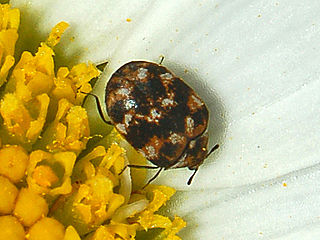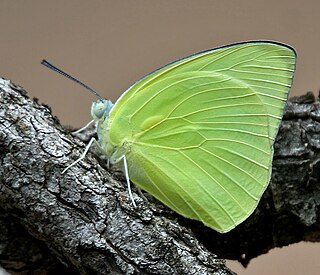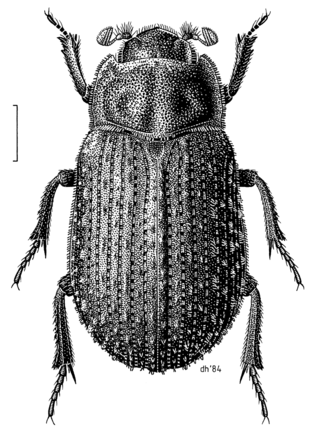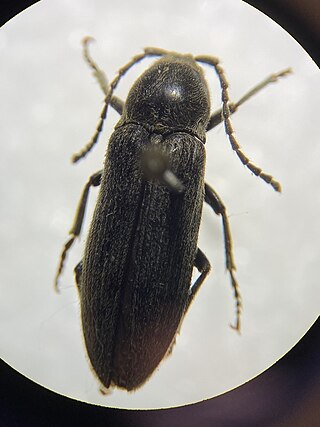
Dermestidae are a family of Coleoptera that are commonly referred to as skin beetles. Other common names include larder beetle, hide or leather beetles, carpet beetles, and khapra beetles. There are over 1,800 species described.

The varied carpet beetle is a 3 mm-long beetle belonging to the family Dermestidae, positioned in subgenus Nathrenus. They are a common species, often considered a pest of domestic houses and, particularly, natural history museums, where the larvae may damage natural fibers and can damage carpets, furniture, clothing, and insect collections. A. verbasci was also the first insect to be shown to have an annual behavioral rhythm and to date remains a classic example of circannual cycles in animals.

Catopsilia pomona, the common emigrant or lemon emigrant, is a medium-sized pierid butterfly found in Asia and parts of Australia. The species gets its name from its habit of migration. Some early authors considered them as two distinct species Catopsilia crocale and Catopsilia pomona.

Trox scaber is a beetle of the family Trogidae. The 5 to 8 mm long insect is found worldwide, including in Europe, and lives in bird nests.

Cebrionini is a tribe of click beetles from the family Elateridae; formerly ranked as a subfamily or family, they are now considered a tribe within the subfamily Elaterinae.
Bucolus fourneti is a native Australian, small, hairy coccinellid beetle approximately 2.1-4.5 mm in diameter. It was described by Étienne Mulsant in 1850
Eustra shanghaiensis, is a species of flanged bombardier beetle belonging to the family Carabidae. It is endemic to China.
Blera analis, the orange-tailed wood fly, is an uncommon species of syrphid fly. It was officially described by Macquart, 1842. Hoverflies get their names from their ability to remain nearly motionless while in flight. The adults are also known as flower flies for they are commonly found around and on flowers from which they get both energy-giving nectar and protein-rich pollen. The larvae are of the rat-tailed type feeding on exuding sap or in the rot holes of trees.

Mycetina cruciata is a species of beetle belonging to the family Endomychidae. M. cruciata is native to Europe.
Harmatelia bilinea, is a species of firefly beetle endemic to Sri Lanka.
Anthrenus ceylonicus, is a species of skin beetle found in Sri Lanka.
Thaumaglossa tonkinea, is a species of skin beetle found in Malaysia, Singapore, Thailand, Vietnam, China, Taiwan and probably Sri Lanka.

Thaumaglossa pici, is a species of skin beetle found in Sri Lanka.
Sceloenopla octopunctata, is a species of leaf beetle found in India and Sri Lanka.

Sphiximorpha willistoni, or Williston's wasp fly, is a rare species of syrphid fly found in eastern North America. It is a strong wasp mimic. Hoverflies can remain nearly motionless in flight. The adults are also known as flower flies for they are commonly found on flowers, from which they get both energy-giving nectar and protein-rich pollen. Larvae in this genus are found in sap runs of trees.

Perothops is a genus of false click beetles in the family Eucnemidae containing 3 species. They are known as beech-tree beetles or perothopid beetles. They are small as they are only 10–18 millimeters long. It is the only genus in the monotypic subfamily Perothopinae. They are dark-colored beetles that are found across the United States, generally in forests. The genus was discovered by Johann Friedrich von Eschscholtz in 1836. It used to be considered a family not part of Eucnemidae. The genus's name is from Greek, translating to "maimed/crippled eye" or "eye of little necklaces/bands", referring to the placement of perothopid eyes.

Solskinus is a subgenus of the genus Anthrenus of the subfamily Megatominae within the family of skin beetles. Subgenus is distinguished by antennae with 7 segments.

Florilinus is a subgenus of the genus Anthrenus of the subfamily Megatominae within the family of skin beetles. Subgenus is distinguished by antennae with 8 segments.
Anthrenus (Helocerus) cechovskyi is a species of carpet beetle in the family Dermestidae. It is known from Nepal.

Anthrenus (Nathrenus) margarethae is a species of carpet beetle native to South Africa.











